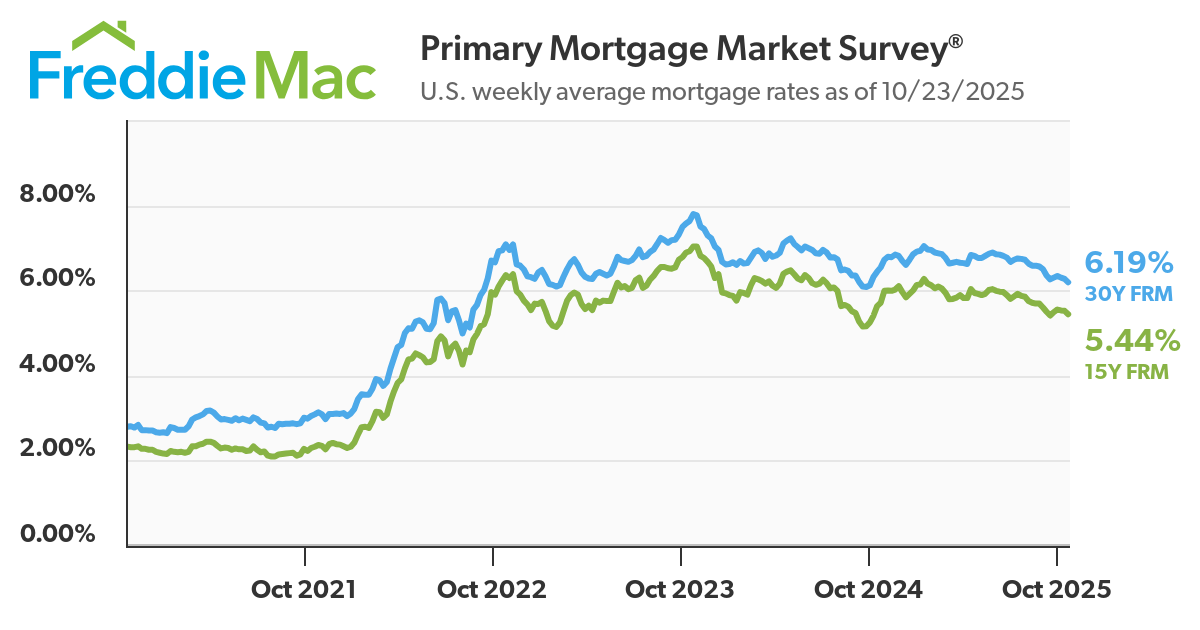
The Federal Reserve has cut rates for the second time this year. The central bank first lowered its benchmark rate at its September meeting, trimming the target range by 25 basis points to 4.25% — 4.50%. With borrowing costs beginning to ease, many homeowners are asking the same question: Is now the right time to sell?
For some, the hesitation to list is understandable. Selling today could mean giving up a low-rate mortgage secured years ago and taking on a higher-rate loan for the next mortgage. Add in limited housing inventory, persistent inflation and elevated prices, and it’s clear why many owners remain on the sidelines.
Still, there are signs of renewed activity. Sales of new single-family homes rose sharply in August to a seasonally adjusted annual rate of 800,000, according to the U.S. Census Bureau and the Department of Housing and Urban Development. That’s 20.5% higher than July’s rate and 15.4% above August 2024 levels. What does that mean for sellers weighing their options? We’ll unpack that next.
Current housing market conditions
One year ago, the average 30-year fixed mortgage rate hovered around 6.44%, according to Freddie Mac. As of Oct. 23, the average rate for a 30-year fixed mortgage has eased to 6.19%, while the 15-year fixed sits at 5.44%.
Thats an improvement from October 2023, when rates peaked at 7.79% amid persistent inflation and a flurry of benchmark rate hikes by the Federal Reserve. Still, borrowers shouldn’t expect a return to the ultra-low mortgage rates seen in 2021.
For sellers, today’s market offers an opportunity. Low housing inventory and steady demand continue to work in sellers’ favor, helping to support higher home prices even as borrowing costs fluctuate. “While inventory has increased over the past year, it still remains below normal levels, favoring sellers,” says Mike Pappas, CEO of The Keyes Company.
Mortgage rates are largely influenced by 10-year Treasury yields, which remain elevated due to ongoing uncertainty about inflation and the broader economy. Even so, modest rate declines can have an outsized effect on demand. “For every 1% drop in interest rates, an additional five million potential homebuyers become qualified at the lower rate,” Pappas adds.
The chart below shows the trajectory of 30-year and 15-year fixed mortgage rates over the past five years.

High prices and limited inventory keep the market tight
Home price growth cooled in August, offering a hint of relief to buyers after years of steep gains. The S&P CoreLogic Case-Shiller Home Price Index showed that single-family home values rose 1.5% year over year, down from 1.6% in July. Marking the slowest annual increase since 2023, when prices briefly declined.
Among the 20 major metro areas tracked by Case-Shiller, home values fell in nine cities, all in the South and West, including Tampa, Phoenix, Miami, San Francisco, Dallas, Denver, San Diego, Seattle and Los Angeles. The moderation could be welcome news for would-be buyers who have struggled with affordability, especially as mortgage rates have begun to lower.
Still, prices remain elevated overall. In September, existing-home sales climbed 1.5% from August, reaching a seasonally adjusted annual rate of 4.06 million units, according to the National Association of Realtors (NAR).
Sales were up 4.1% from a year earlier, and the median existing-home price rose 2.1% year-over-year to $415,200. Marking the 27th consecutive month of annual price gains. Housing inventory totaled 1.55 million units, equating to a 4.6-month supply, unchanged from August but up from 4.2 months a year ago.
While the pace of appreciation is slowing, home values remain high by historical standards, and for sellers, the direction of mortgage rates could determine how much leverage they have in the months ahead.
How mortgage rates impact sellers
A lower federal funds rate influences all kinds of borrowing costs, including mortgage rates. Homeowners with home equity lines of credit (HELOCs) or adjustable-rate mortgages (ARMs) should see some savings as interest rates drop. And anyone who bought when rates were higher may finally benefit from refinancing.
While lower rates can help existing borrowers, they also shape the broader housing market. Cheaper borrowing costs tend to bring more buyers back into play, which can boost demand and help sellers attract stronger offers. Conversely, when rates rise, buyers pull back, forcing sellers to price more competitively or offer concessions to close a deal.
Many would-be sellers remain “locked in” to ultra-low mortgage rates from a few years ago. Even after two Fed rate cuts, today’s 6% mortgages are still well above the 3% loans many owners refinanced into during the pandemic. That gap discourages moves unless there’s a major life change or financial need.
Still, falling rates could spur a modest wave of refinancing and home-equity borrowing, allowing homeowners to remodel, consolidate debt or fund other goals without selling. For those with ARMs or HELOCs, lower rates can free up monthly cash flow, sometimes enough to make staying put more attractive. If borrowing costs continue to slide into 2026, more sellers may re-enter the market, easing the inventory crunch that’s kept prices high.
Should you sell your home now?
Selling a home is always a personal decision, but recent rate cuts and shifting market conditions may make now a more favorable time. Here are three reasons why it could make sense to list sooner rather than later.
1. Interest rate cuts
Lower borrowing costs often bring more buyers into the market, creating stronger demand and faster sales. As mortgage rates ease, sellers may find themselves fielding more offers and negotiating better terms.
For homeowners who’ve been waiting to downsize or relocate, a lower-rate environment can make the transition more affordable while also boosting overall housing supply.
2. Rising home equity
Many homeowners have built up substantial equity as home prices climbed over the past few years. That equity can serve as a cushion when moving, allowing you to make a larger down payment, pay off debt or upgrade to your next home with less financial strain.
Selling while values remain high can help you lock in those gains before the market adjusts further.
3. Favorable market conditions
Even as price growth slows, inventory remains tight. With more buyers competing for fewer homes, sellers could still see strong prices and even bidding wars in some areas. Listing while conditions are in your favor could help you secure top dollar before the next market shift.
Should you wait and sell your home until later?
Not every homeowner will benefit from selling right now. Here are a few reasons it might make sense to hold off.
1. Inflation and higher costs
While rate cuts can help stimulate demand, inflation remains sticky in many parts of the economy. Sellers may still face higher moving expenses, taxes and closing costs. Finding a new home at a comfortable price point could also be challenging.
2. You’ve recently refinanced
If you refinanced in the past few years, it may not be worth selling yet. Closing costs typically range from 2% to 5% of your loan balance, which can take years to recoup. Selling too soon could wipe out the savings you gained from refinancing.
3. Your home needs major repairs
Big-ticket fixes like replacing a roof or windows can quickly add up. If your home needs significant work, waiting until you’ve made improvements, or until your budget allows for them, could help you command a higher sale price later.
Bottom line
Falling rates and steady demand are bright spots for sellers, but the decision ultimately depends on your financial situation and long-term goals.
If you have strong equity and plan to move anyway, now could be an advantageous time to list. But if affordability, repairs or timing are concerns, waiting for a more balanced market might be the smarter move.
Curious about today's mortgage rates? Use the tool below to explore and compare some of today's top mortgage offers, powered by Bankrate:







